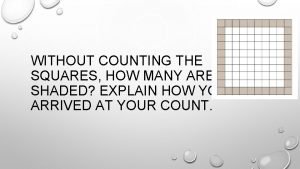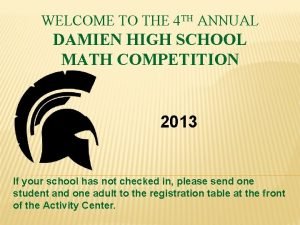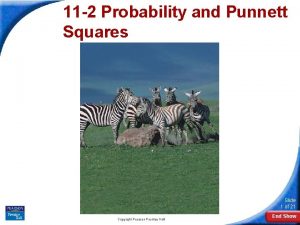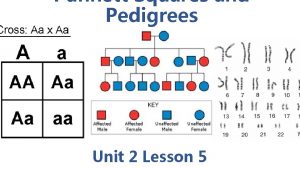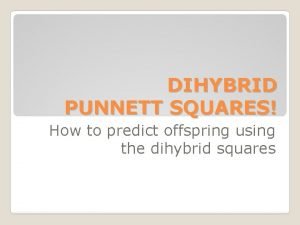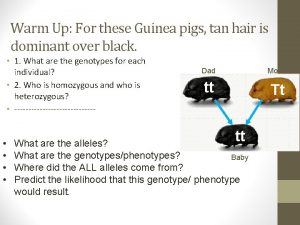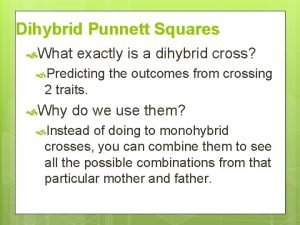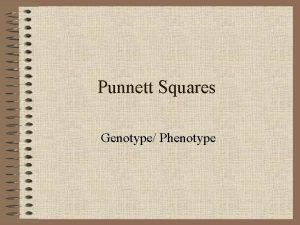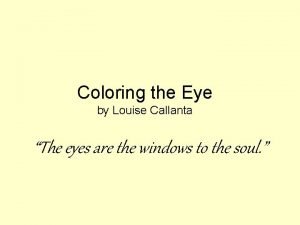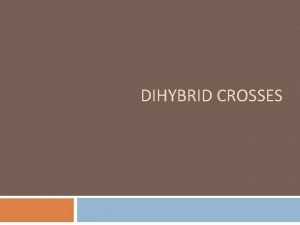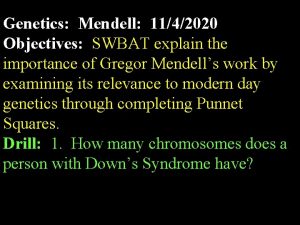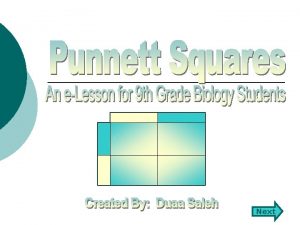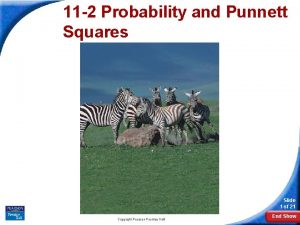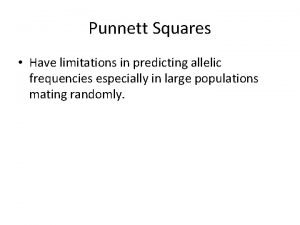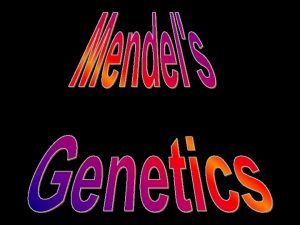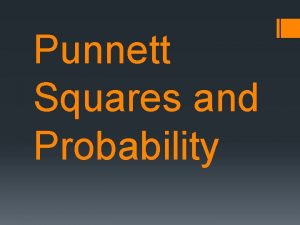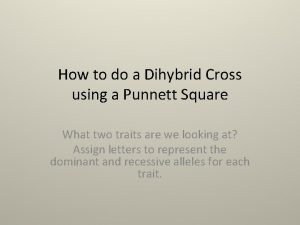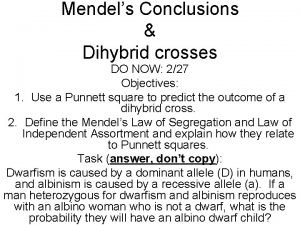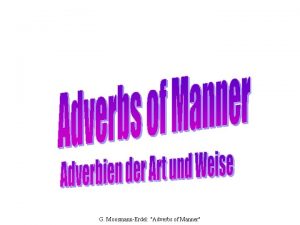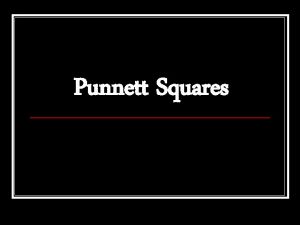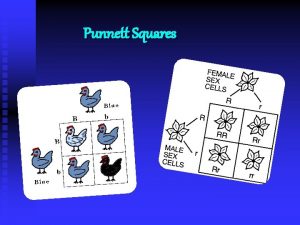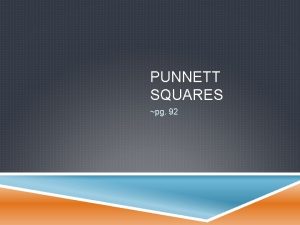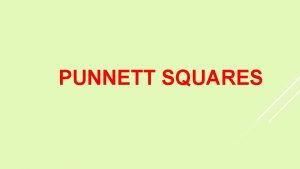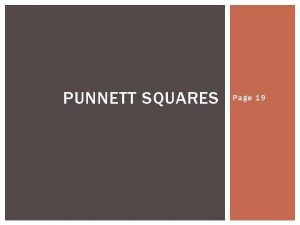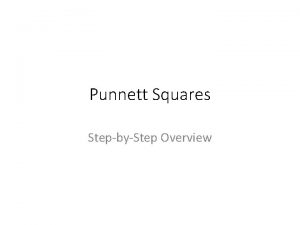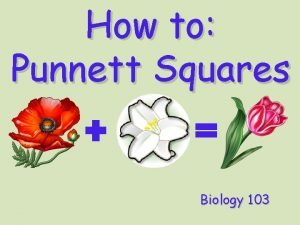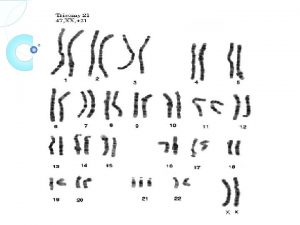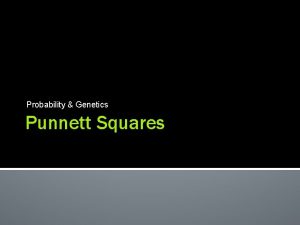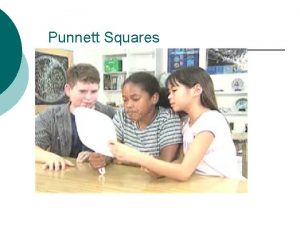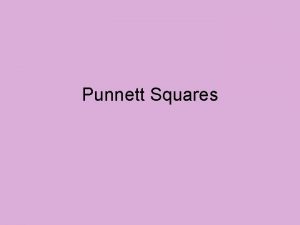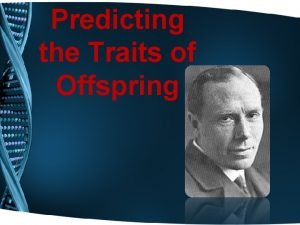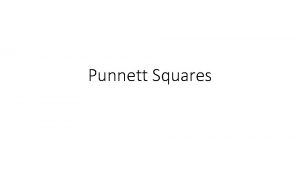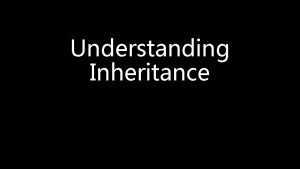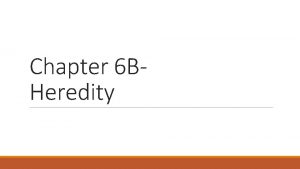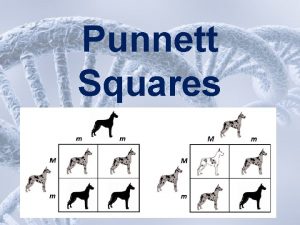Next Punnett Squares Welcome Welcome to the wonderful

































- Slides: 33

Next

Punnett Squares Welcome! Welcome to the wonderful world of Punnett squares! This e-lesson is here to introduce you to the concepts behind Punnett squares and what they are used for! Goals By the end of this e-lesson, the 9 th grade Biology student will be able to: l l Comprehend the relationship between probability and genetics Construct and use Punnett squares to perform theoretical genetic monohybrid crosses Apply the principles of probability to genetic crosses Determine phenotypes and genotypes using Punnett squares Next

Punnett Squares Let’s Begin! A Punnett square is a diagram which shows the possible gene combinations in a cross of parents whose genes are known. These genes are represented by two alleles—one allele coming from each parent. Punnett squares are also used to determine the probability of offspring having a specific genotype, displaying a certain phenotype, and whether the offspring will be homozygous or heterozygous for these traits. Back Allele? Genotype? Phenotype? Homozygous? Heterozygous? . . You may be questioning what in the world these words mean! In order to understand Punnett squares, you’re going to have to understand these words. So, let’s take a look at what they mean… Next

Punnett Squares Allele – the different forms of a gene; each trait is represented by one letter—the varieties in the trait are represented by a CAPITAL letter (if the gene is DOMINANT) or lowercase letter (if the gene is recessive) (Example: in the trait of eye color, the brown eyes gene is dominant over the blue eyes gene; therefore, brown eyes will be represented by the allele “B” and blue eyes will be represented by the allele “b”) = brown eyes Back = blue eyes Next

Punnett Squares Genotype – the genetic makeup; it is the combination of two letters after the cross is done (remember genotype = genetic) Back (Example: someone with blue eyes would have “bb” because the only way they can have blue eyes is by receiving the recessive gene for eye color from both parents; however, someone with brown eyes may have received the dominant gene from one parent or from both—all they need is the dominant gene from one parent in order for it to physically show—therefore, a person with brown eyes could have the “BB” genotype if they received the gene for brown eyes from both parents or the “Bb” genotype if they received the gene for brown eyes from one parent but carry the gene for blue eyes from another parent) Next

Punnett Squares = brown eyes = blue eyes Back Next

Punnett Squares Phenotype – the physical characteristic; it is the “translation” of what the letters tell you (remember phenotype = physical) (Example: brown eyes is one phenotype in the previous example and blue eyes is the second) Back Next

Punnett Squares Homozygous – having two identical alleles; the person possesses both dominant genes or both recessive genes (Example: BB, bb, TT, tt, HH, hh) Heterozygous – having two different alleles; the person displays the dominant trait which they received from one parent but carries the recessive gene they received from the other parent; the person has one dominant gene and one recessive gene (Example: Bb, Tt, Hh) Back Next

Punnett Squares Now that you have a better understanding of what these words mean, let’s continue! The genes in your body are “codes” for individual traits. Each trait is represented by a gene! When constructing a Punnett square, you may predict the chances of an offspring having blue eyes for instance. You can also create a more complex Punnett square to predict the chances of an offspring having blue eyes and blonde hair! The more traits you are observing in a Punnett square, the larger your square will be and the more complicated it is! For this lesson, we will focus on predicting the chances of offspring possessing certain traits—one trait at a time. When looking at only one trait at a time, we will be creating what is called a monohybrid cross. Back Next

Punnett Squares In order to understand the structure of a monohybrid Punnett square, let’s take a look at the number of genes we are working with! Every gene you possess is made up of a gene passed to you from your mother and a gene passed to you from your father. Therefore, every gene in your body has “two parts” to it. These parts are represented by alleles as mentioned earlier. In order to pass on traits to your offspring, your offspring need another parent to pass along the other half of the genes your offspring will possess. So, if a parent has two alleles (one from their mother, one from their father), the other parent will have the same! This means, we will be dealing with four alleles when constructing our Punnett square. Back Next

Punnett Squares The next important thing to understand is that a parent contributes “half” of their gene for a trait to their child so that the other parent contributes the other “half. ” This means that the allele combination (the genotype of two alleles) has to be divided in order to determine the different combinations that can form from the four “halves” crossing one another. When two halves are crossing with two halves, you end up with four different “wholes” (2 x 2 = 4). Therefore, we will have four squares in our Punnett square. Back Next

Punnett Squares Crossing the two “halves” from the mother and two “halves” from the father provides us with the following Punnett square structure: One Parent Back Combinations Next

Punnett Squares Now that you have an understanding of the concept, the terms, and the structure, let’s take a look at an example! Example Question: A mother’s genotype is heterozygous for brown eyes and a father has blue eyes. Construct a Punnett square to determine the possible genotypes and phenotypes, as well as their ratios. To begin our work, let’s list the information given to us in the question: Back Next

Punnett Squares Mother = heterozygous brown Father = blue Back As you recall from earlier in the presentation, the word heterozygous means having one of each type of allele (one capital, one lowercase). This means the parent carries a dominant gene and a recessive gene. What this also means is that since they carry a dominant gene, that is the gene they exhibit. If you translate that thought for this problem, you realize that “heterozygous brown” means that brown is the dominant gene! This lets you know that brown will be represented by a capital letter and blue will be represented by a lowercase letter. What this also means is since brown is dominant, blue is recessive! The only way to exhibit a recessive gene is to carry the recessive gene from both parents (since it only takes ONE dominant gene to show off a dominant feature). Therefore, we also know that the father’s genotype is two lowercase alleles. Next

Punnett Squares Now, to begin mapping out our work, we need to choose a letter to represent eye color. Let’s assign the letter “B. ” Mother = heterozygous brown = Bb* Father = blue = bb *Rule: Capital letter comes before lowercase (dominant before recessive)! In order to perform the cross, we need to “separate the halves” for each parent. This means we will be crossing: Mother (B Father (b Back b) b) Next

Punnett Squares Now, we need to draw out our square and then place the genotypes for the father and mother: Father b Mother b Back Next

Punnett Squares Now, we perform the cross! Look at the arrows below to see how the cross is done. It’s as easy as that! b Back b B Bb Bb b bb bb Next

Punnett Squares Looking at the Punnett square, list the 4 results: Bb, bb, bb You notice there are 2 different genotypes: Bb and bb Back b b B Bb Bb b bb bb When you count how many times you see each genotype, you notice the genotype ratio is: 2 Bb’s to 2 bb’s (2: 2) The 2 phenotypes are brown eyes and blue eyes. You realize that 2 out of the 4 results contain the dominant gene. This means those 2 exhibit the dominant gene, brown eyes, and so, the other 2 must exhibit blue eyes. So, the phenotype ratio is: 2 Brown Eyes to 2 Blue Eyes (2: 2) Next

Punnett Squares Now, let’s interpret the results using the principles of probability: Genotype Ratio: 2 Bb’s to 2 bb’s (2: 2) Phenotype ratio: 2 Brown Eyes to 2 Blue Eyes (2: 2) The genotype ratio shows that EACH offspring has a 2 out of 4 (50%) chance of having a genotype of Bb (brown eyes, carrying blue eye gene) and a 2 out of 4 (50%) chance of having a genotype of bb (blue eyes, carrying only blue eyes gene). The genotype ratio also shows that none of the offspring have a chance of being homozygous dominant for brown eyes (they will always at least carry the recessive gene for blue eyes). The phenotype ratio shows that every offspring has a 2 out of 4 (50%) chance of having brown eyes and a 2 out of 4 (50%) chance of having blue eyes. Back Summary: Every child has a 50% chance of having brown eyes and a 50% chance of having blue eyes. Next

Punnett Squares Practice!!! Now that you’re familiar with how to create and use Punnett squares, create 3 different situations (=3 different questions), construct a Punnett square for each, perform the cross, and find the genotype ratio and phenotype ratio. Make sure to go through each of the steps mentioned in this lesson to help you out. Feel free to go back in this lesson for help! When you have finished practicing, return to this page to begin assessment of your knowledge of Punnett squares! Back Begin Assessment!

Punnett Squares Assessment Question 1: In pea plants, spherical seeds are dominant to dented seeds. In a genetic cross of two plants that are heterozygous for the seed shape trait, what fraction of the offspring should have spherical seeds? a. b. c. d. 1 out of 4 (25%) 2 out of 4 (50%) 3 out of 4 (75%) 4 out of 4 (100%) spherical dented

Punnett Squares Assessment Question 2: In rabbits, the allele for black fur is dominant over the allele for brown fur. A rabbit that is homozygous for black fur is crossed with a rabbit that is homozygous for brown fur. What chance do the offspring have of being born with black fur? a. b. c. d. 1 out of 4 (25%) 2 out of 4 (50%) 3 out of 4 (75%) 4 out of 4 (100%)

Punnett Squares Assessment Question 3: A homozygous bald man marries a woman who only carries the gene for baldness. What chance do the children have of being bald? a. b. c. d. 1 out of 4 (25%) 2 out of 4 (50%) 3 out of 4 (75%) 4 out of 4 (100%)

Punnett Squares Assessment Question 4: A father and mother are both heterozygous tall. What are the chances that their children will be short? a. b. c. d. 1 out of 4 (25%) 2 out of 4 (50%) 3 out of 4 (75%) 4 out of 4 (100%)

Punnett Squares Wonderful job!!! Proceed to Question 2!

Punnett Squares That is incorrect!! S S SS s S = spherical s = dented Ss Genotype Ratio: 1 SS: 2 Ss: 1 ss Phenotype Ratio: 3 Spherical: 1 Dented s Ss ss 75% Spherical 25% Dented Proceed to Question 2!

Punnett Squares Wonderful job!!! Proceed to Question 3!

Punnett Squares That is incorrect!! B b Bb B B = Black b = brown Bb Genotype Ratio: 4 Bb: 0 Phenotype Ratio: 4 Black Fur b Bb Bb 100% Black Fur 0% Brown Fur Proceed to Question 3!

Punnett Squares Wonderful job!!! Proceed to Question 4!

Punnett Squares That is incorrect!! Father h H Hh h H = hair/non-bald h = bald Hh Genotype Ratio: 2 Hh: 2 hh Mother Phenotype Ratio: 2 Hair/Non-bald: 2 Bald h hh hh 50% Hair/Non-Bald 50% Bald Proceed to Question 4!

Punnett Squares Wonderful job!!! Next

Punnett Squares That is incorrect!! T T TT t T = tall t = short Tt Genotype Ratio: 1 TT: 2 Tt: 1 tt Phenotype Ratio: 3 Tall: 1 Short t Tt tt 75% Tall 25% Short Next

Punnett Squares You have just completed your very first Punnett Squares e-lesson! Please feel free to review this lesson as many times as you would like until you are absolutely comfortable with performing monohybrid crosses! Congratulations on completing the lesson! Home Exit
 X.next = x.next.next
X.next = x.next.next Wonderful wonderful jesus
Wonderful wonderful jesus Antenati
Antenati God's love is so wonderful
God's love is so wonderful How many squares
How many squares My age
My age Section 11-2 probability and punnett squares
Section 11-2 probability and punnett squares Pedigree
Pedigree X-linked punnett square
X-linked punnett square Foil method dihybrid cross
Foil method dihybrid cross Punnet square
Punnet square Pyr
Pyr Punnett square for o blood type
Punnett square for o blood type Section 11-2 probability and punnett squares
Section 11-2 probability and punnett squares Phenotype punnett square
Phenotype punnett square Hazel eye punnett square
Hazel eye punnett square How to foil alleles
How to foil alleles Hemophilia punnett square worksheet
Hemophilia punnett square worksheet Punnett square example
Punnett square example Tt x tt punnett square
Tt x tt punnett square Punnett square meaning
Punnett square meaning A and b punnett square
A and b punnett square 11-2 probability
11-2 probability Limitations of using a punnett square
Limitations of using a punnett square Punnett squares
Punnett squares Punnett square for o blood type
Punnett square for o blood type Dihybrid cross using foil method
Dihybrid cross using foil method Dihybrid cross conclusion
Dihybrid cross conclusion I hope you had a nice summer welcome to third grade
I hope you had a nice summer welcome to third grade Adverbs of manner careful
Adverbs of manner careful Line of poetry
Line of poetry Mv wonderful grace
Mv wonderful grace Internet culture memes
Internet culture memes Esau wood poem
Esau wood poem




